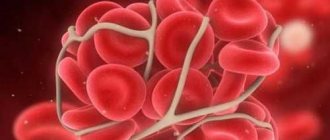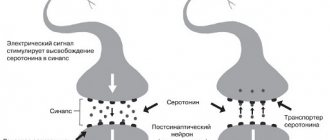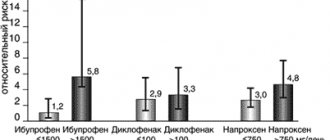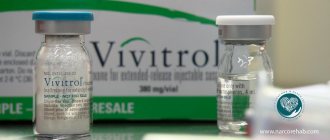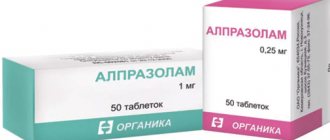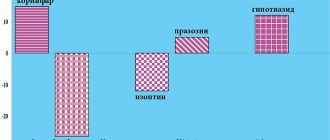Classification of drugs and indications
Medicines are divided into groups based on their therapeutic effect and mechanism of influence on the body. There are only 2 types of anticoagulants: direct and indirect.
Direct anticoagulants
The mechanism of action of the drugs is associated with the activity of components that promote the unification of red blood cells, leukocytes and platelets, the rapid restoration of the integrity of affected vessels that are damaged due to the influence of the causative factor.
The main compound affected by direct anticoagulants is thrombin. The components of the drugs stop its activity without changing the volume of content. The structural element of blood is produced in normal quantities and can be detected by laboratory analysis.
Medicines are rapidly metabolized, processed and eliminated from the human body. The therapeutic effect is not long-lasting. Severe adverse reactions, including severe internal bleeding, may occur. For this reason, treatment with direct anticoagulants is carried out under the supervision of a physician. Tablets are prescribed for the treatment of the following diseases:
- Thrombosis
. More often, corresponding changes are diagnosed in the large vessels of the legs, which are characterized by the formation of blood clots that block the lumen. In the initial stages of the disease, you can get by with anticoagulants that restore blood circulation. In the later stages, medications that are classified as thrombolytics are prescribed. - Pulmonary embolism
. The pathology occurs with an increase in pressure in the corresponding structure, which causes disruption of the heart. In this case, anticoagulants are prescribed in complex therapy. - Thrombophlebitis
. The disease is characterized by the formation of blood clots in the vessel and the development of an inflammatory reaction. Drugs from the group of anticoagulants are used in combination with other etiotropic and symptomatic drugs. - Angina pectoris
. Treatment with anticoagulants is effective due to the absence of areas with death of organ tissue. With timely initiation of therapy, a favorable prognosis occurs, which means the risk of complications is minimized. - Acute myocardial infarction
. Tablets are prescribed at any stage of the pathology, including in the post-infarction period to prevent the formation of blood clots. - Autoimmune disorders
related to kidney function (lupus nephritis, etc.), systemic pathologies.
In the treatment of hemorrhoids, the best drugs are in the form of ointments and suppositories, which are easier to use.
Indirect anticoagulants
The difference between direct and indirect anticoagulants is in action. The latter have a complex effect, unlike the other group of drugs. The drugs affect thrombin, but do not suppress activity, but completely destroy it. The mechanism of action of these is also associated with the influence on other coagulation factors, including the rate of aggregation.
Indirect anticoagulants not only help thin the blood, but also restore nutrition to myocardial tissue, relieve spasm from blood vessels, and accelerate the removal of organic salts and excess cholesterol from the body.
Given their complex action, anticoagulants have a large list of possible adverse reactions, especially with long-term use.
Drugs are prescribed for the treatment of the following conditions:
- chronic heart failure, atrial fibrillation;
- severe thrombosis of the deep veins of the lower extremities, if other medications do not help get rid of the pathology;
- recurrent myocardial infarction;
- disruption of the pulmonary artery (in this case, indirect anticoagulants are combined with thrombolytic drugs, despite the risk of developing dangerous complications as a result of complex use).
Indirect anticoagulants are also prescribed for diseases that are treated with drugs from the direct group. The difference is that the former are more often used in chronic pathologies, and the latter in the treatment of acute conditions.
Indications and contraindications for anticoagulant therapy
Anticoagulants are substances that inhibit blood clotting activity. They have a wide spectrum of action, minimizing exacerbations of diseases of the cardiovascular system in the form of strokes and heart attacks. By starting treatment with anticoagulants in a timely manner, it is possible to prevent the formation of blood clots in blood vessels with their subsequent blockage and the development of a number of serious complications.
Usually blood clots are tightly fixed to the walls of blood veins, but under the influence of blood flow, elevated temperature, blood pressure or physical stress they can come off. This situation arises suddenly, and a person’s life in it depends on how correctly and quickly medical care is provided to him. The consequences can be the most tragic: from stroke and heart attack to pulmonary embolism and thrombosis of the leg veins. Correct use of anticoagulants can eliminate these complications.
| Indications for anticoagulant therapy: | Contraindications to the use of anticoagulants: |
| Taking anticoagulants is not recommended for pregnant women, as it can cause disturbances in the embryonic development of the fetus and bleeding during the gestational period. It is also not recommended for patients suffering from:
|
Effective drugs
Direct anticoagulants exist in the form of tablets, ointments, gels, and solutions for subcutaneous or intravenous administration. The components of the drugs are quickly absorbed into the bloodstream, the therapeutic effect lasts throughout the day. The list of direct-acting anticoagulant drugs and the features of administration can be placed in the table:
| Name | Release form | Dosage and frequency of administration | approximate price |
| Heparin ointment | Ointment | 0.5-1 g topically twice a day | From 65 rub. |
| Lyoton | Gel | 3-10 cm of gel topically three times a day | From 350 rub. |
| Venitan | Gel | Apply a thin layer, without rubbing, topically, three times a day | From 260 rub. |
| Fraxiparine | Solution | Subcutaneously or intravenously, taking into account body weight | From 2100 rub. |
| Clexane | Solution | Subcutaneously at a dose prescribed by your doctor | From 570 rub. |
The names of effective indirect anticoagulants are in the table:
| Group | Name | Release form | Dosage and frequency of administration | approximate price |
| Monocoumarins | Warfarin | Pills | Initial dose: 10 mg per day | From 80 rub. |
| Markumar | Pills | Initial dose - 4-6 tablets with a gradual decrease in daily volume | From 3500 rub. per pack of 100 pcs. | |
| Sinkumar | Pills | Initial dose - 4-8 tablets with a gradual decrease in daily volume | From 580 rub. | |
| Dicumarins | Tranexam | Pills | The doctor calculates the dose based on the indication | From 250 rub. |
| Indandions | Omefin | Pills | Initial dosage - 0.05 g per day | No data available |
| Fenilin | Pills | Initial dosage - 0.12-0.2 g in 3-4 doses | From 150 rub. |
There is another group of anticoagulants - a new generation, which include Apixaban, Rivaroxaban, Dabigatran. Medicines are under development. Advantages - rapid therapeutic effect, fewer side effects, no risk of internal bleeding. These are often prescribed to prevent stroke in people with atrial fibrillation.
As part of the second congress of the Eurasian Arrhythmological Association and the eighth congress of cardiologists, cardiac surgeons and x-ray endovascular surgeons of the Republic of Belarus, a symposium “Complex cases in cardiology” was held. Experts focused on antithrombotic treatment and its complications in patients with atrial fibrillation who have had a stroke.
Global Burden
Natalya Koziolova, Doctor of Medicine. Sciences, ProfessorHead of the Department of Propaedeutics of Internal Diseases No. 2, Perm State Medical University named after. Academician E. A. Wagner (Russia), member of the presidium of the board of the Russian Society of Cardiology, President of the Perm Regional Cardiological Society, Doctor of Medicine. Sciences, Professor Natalya Koziolova shared new data on secondary prevention of stroke in patients with atrial fibrillation (AF).
First of all, Natalya Andreevna drew attention to the urgency of the problem. Thus, according to research, in 2019 alone, 12.2 million strokes were diagnosed in 204 countries: 7.63 million ischemic strokes, 3.41 million cerebral hemorrhages, 1.18 million subarachnoid hemorrhages. Over 29 years, as a result of this pathology, 143 million people became disabled. In the structure of causes of disability, both in 1990 and in 2019, strokes took second place.
Natalya Koziolova:
It is worth noting that the frequency of pathology is increasing among people aged 18–50 years. There are 2 million such patients per year in the world, and this number is increasing. However, knowledge about the global distribution of risk factors and etiology, as well as information about prognosis and optimal secondary prevention in young patients, is insufficient. This limits evidence-based treatment and prevents the provision of relevant information about stroke causes, risk factors and prognosis.
Traditionally, according to the expert, ischemic strokes, as well as intracranial and subarachnoid hemorrhages, lead to death. In Russia in 2015, more than 300 thousand ischemic strokes and more than 66 thousand hemorrhagic strokes were registered. Among ischemic strokes, the leading one is atherothrombotic, every fifth is cardioembolic.
Natalya Koziolova:
Enormous efforts are invested in the treatment of patients with cerebral catastrophes, and not only medical ones. A federal project is being implemented in Russia: for 2 years, patients after a stroke are given free medications, including the best and most expensive direct oral anticoagulants. The patient is required first of all to be committed to treatment. Morbidity and mortality are decreasing slightly, but still, according to one of the statistical databases in 2021, Russia ranked first in the world in terms of mortality from stroke.
In the USA, for example, huge amounts of money are also spent on treating patients with stroke. However, since 2013, there has been a negative trend towards an increase in mortality from this pathology, regardless of age. By the way, in the United States, every 20th patient in the age category 60–79 years has suffered a stroke.
Natalya Koziolova:
According to studies, if a 60-year-old patient follows recommendations for stroke prevention, he will survive 20 years. In case of a stroke, survival time is reduced to 8 years.
The incidence of recurrent stroke in Russia (according to the National Stroke Registry), according to the expert, is huge - 0.79 per thousand population. The share of ischemic among recurrent strokes is 87.5%, of unspecified etiology - 4.6%. The prevalence rate of recurrent stroke among all strokes is 25.5%. Every 5th patient in Russia has a recurrent stroke.
Natalya Koziolova:
For a long time it was believed that the most dangerous period after a stroke was the first month and first year. Unfortunately, the latest data suggests that in fact, 1 in 5 people will die within 4 years of having a second stroke. In the 3rd–5th year, patients calm down and adherence to treatment is impaired.
Error Analysis
Natalya Koziolova:
In the presence of AF, the risk of cardioembolic stroke increases almost 16 times. Therefore, patients with AF should be treated with great care, especially if they have already suffered a stroke.
An expert analyzes a case from practice. A 67-year-old woman consulted a therapist with complaints of fatigue, weakness, insomnia, and recurrent headaches. Eight months ago she suffered an ischemic stroke in the right hemisphere. She has had a persistent form of AF for four years (8–19 paroxysms per year), as well as hyperlipidemia (a risk factor for recurrent stroke) for 7 years (LDL cholesterol - 3.1 mmol/l with a target level of less than 1.4 mmol/l ).
Natalya Koziolova:
Let's analyze the errors. The patient takes atorvastatin only 20 mg per day. In this case, we can talk about medical inertia: the specialist prescribed atorvastatin and stopped there,” Natalya Koziolova points out. “In addition, the patient has had hypertension for 10 years without achieving the target blood pressure level. She came to the appointment with a blood pressure of 160/95 mm Hg. Art. Question for the doctor who prescribed perindopril 10 mg per day and indapamide 1.5 mg per day and again stopped there.
The patient also has type 2 diabetes for 4 years. Taking into account age and previous stroke, the target glycated hemoglobin is 7.5% (takes dapagliflozin 10 mg per day). What does the patient gain from antithrombotic therapy? Only aspirin 100 mg per day, but continues to take (8 months) 2 more cerebroprotectors. What does the American recommendations say about this?
Today, pharmacological or non-pharmacological treatment using neuroprotective agents is not recommended: there is no evidence base for improving quality of life and prognosis. According to the CHA2DS2-VAС scale, the patient’s risk of stroke is very high – 6 points. The risk of hospitalization and death due to thromboembolic complications increases 20 times within a year! In this case, only aspirin was prescribed. The risk of bleeding on the HAS-BLED scale is 4 points (high).
Additionally, non-modifiable risk factors are taken into account. In the case of this patient, these are age, a history of ischemic stroke, and type 2 diabetes. Potentially modifiable risk factors include impaired renal function; modifiable risk factors include arterial hypertension, the risk of thrombosis and bleeding.
Natalya Koziolova:
We can correct two factors: we can treat hypertension and stop aspirin. There is still a high risk of bleeding and a very high risk of recurrent stroke. What to prescribe in this case? Of course, anticoagulants (ACs), with the new oral anticoagulants (NOACs) now being preferred over vitamin K antagonists (VKAs)—except in patients with mechanical heart valves or moderate-to-severe mitral valve stenosis.
European recommendations state that antiplatelet agents (not just aspirin, but any) in monotherapy or in combination with clopidogrel are not recommended for the prevention of stroke in patients with AF - the risk of bleeding increases, but the risk of stroke does not decrease.
Indications and choice of oral anticoagulants (OAC) for AF:
- OACs are recommended for the prevention of stroke in patients with results on the CHA2DS2-VAS scale of 2 or more points in men, 3 or more points in women.
- If the risk of stroke is assessed as low (on the CHA2DS2-VAS scale 0 points in men, 1 point in women), antithrombotic therapy is not recommended.
- OAC should be considered for stroke prevention in patients with AF with a CHA2DS2-VAS score of 1 in men and 2 in women.
- Treatment should be individualized based on pure clinical benefit and taking into account patient benefits and preferences.
According to the updated 2021 European Society of Cardiology (ESC) guidelines, in patients with AF and ischemic stroke or transient ischemic attack (TIA), long-term secondary stroke prevention with OACs is recommended in the absence of absolute contraindications, with NOACs being preferred over VKAs in patients , which are suitable for PLA.
In patients with AF and acute ischemic stroke, early anticoagulation (<48 hours) with low molecular weight heparins (LMWH), unfractionated heparin, or VKAs is not recommended. This is a risk factor for early hemorrhagic transformation.
Natalya Koziolova:
Why NOACs and not VKAs (warfarin) in patients with AF after ischemic stroke or TIA? A meta-analysis of 4 randomized clinical trials showed that NOACs, compared with warfarin, statistically significantly reduce recurrent strokes and systemic embolisms by 13.7%, hemorrhagic strokes by 50%, any strokes by 13.1%, intracranial hemorrhages by 46.1%, - explains Natalya Koziolova.
The expert notes that nothing has changed in the American recommendations since 2014. The European drug rivaroxaban is preferred. According to studies, rivaroxaban compared with warfarin reduced the risk of recurrent stroke by a statistically significant 52% without increasing the risk of major bleeding, with a clinical benefit of 55%.
The combination of OACs (warfarin, NOACs) with antiplatelet agents is not recommended after ischemic stroke or TIA.
For patients with AF who have had an ischemic stroke or TIA and who cannot take OACs, aspirin or a combination of aspirin and clopidogrel is recommended.
Natalya Koziolova:
What should not be done when we talk about preventing a recurrent stroke, especially in the first month? Warfarin should not be prescribed, since in the first month the risk of recurrent ischemic events increases by 71%. Warfarin doesn't work yet. In addition, it has been proven that warfarin in patients with AF increases the risk of all types of dementia, because it causes vitamin K deficiency, which increases the risk of calcification and increases the risk of vascular accidents.
Antithrombotic therapy and intracranial hemorrhage
Natalya Mitkovskaya, Director of the Republican Scientific and Practical Center "Cardiology", Head of the Department of Cardiology and Internal Diseases of the Belarusian State Medical University, Doctor of Medicine. Sciences, professor. Director of the Republican Scientific and Practical Center “Cardiology”, head of the Department of Cardiology and Internal Diseases of the Belarusian State Medical University, chief freelance specialist in cardiology of the Ministry of Health, Doctor of Medicine. Sciences, Professor Natalya Mitkovskaya drew attention to the risk factors for bleeding in a patient with AF during antithrombotic therapy.
Natalya Mitkovskaya:
Any cerebral infarction is accompanied by a certain percentage of hemorrhages, and our ability to successfully navigate between the risks of cerebral infarction and intracranial hemorrhage determines the patient’s chances of survival.
The CHA2DS2-VAСс and HAS-BLED scales should be on the desktop, mobile phone, computer of every general practitioner, therapist and cardiologist. Indeed, new oral anticoagulants occupy a leading position in the prevention of cerebral infarction in patients with AF, and they must be prescribed taking into account the indications, the risk of bleeding, and not forgetting to monitor the functional state of the kidneys and other organs. However, more than half of patients after cerebral infarction do not receive OAC, 50% of them are over 80 years of age.
Natalya Mitkovskaya draws attention to the importance of monitoring and correcting risk factors for bleeding (according to the 2020 ESC recommendations) ( see table ).
Table. Risk factors for bleeding
The 2021 American Heart Association/American Stroke Association (AHA/ASA) guidelines state that in patients who are eligible for alteplase treatment for stroke, the benefit is time dependent: treatment should be initiated as early as possible.
- Intravenous alteplase (0.9 mg/kg, maximum dose 90 mg over 60 minutes with an initial bolus of 10% of the dose over 1 minute) is recommended for patients who are admitted for treatment within 3 hours of the onset of ischemic symptoms. stroke or since the last time asymptomatic (IA) was established.
- Administration of alteplase is also recommended for patients presenting for treatment within 3 and 4.5 hours of the onset of ischemic stroke symptoms or the last time symptom-free was established (I BR—moderate-quality evidence from one or more RCTs) ).
Natalya Mitkovskaya:
It is fundamentally important to note in the medical documentation when the primary medical contact between the doctor and the patient took place, when an ECG or other study was performed, and when the administration of the drug began. The time interval is the patient's life.
- Administration of alteplase for 4.5 hours is also recommended for patients who awaken with stroke symptoms or have an unclear onset time >4.5 hours from the onset of stroke symptoms or the last time asymptomatic, when the lesion is less than one third detected on MRI zones of vascularization of the middle cerebral artery and the absence of visible signal changes in FLAIR mode.
- For small intracranial hemorrhage (1–10 mL) on MRI, alteplase (IIA BR) may be considered.
- In patients eligible for thrombolytic therapy who have cerebral hemorrhage (>10 mL) confirmed by MRI, alteplase may be associated with an increased risk of recurrent clinically significant hemorrhage, and the benefit of treatment has not been determined. The use of alteplase may be justified if there is potential for significant benefit.
- Intravenous aspirin should not be administered within 90 minutes of the initial use of alteplase. The ARTIS study found that intravenous aspirin use was associated with an increased risk of clinically significant intracranial hemorrhage.
- But the use of aspirin orally is recommended in patients with cerebral infarction 24–48 hours after its development. When using alteplase, administration of aspirin 24 hours after the event is appropriate, but the approach must be individualized with careful assessment of comorbid conditions, benefits and risks.
- Alteplase should not be administered to patients who have received a treatment dose of low molecular weight heparin within the previous 24 hours.
- Blood pressure should be maintained at <180/105 mmHg. Art. at least 24 hours after the start of intravenous alteplase administration.
- The risk of antithrombotic therapy (other than intravenous aspirin) during the first 24 hours after administration of alteplase (with or without mechanical thrombectomy) should be considered individually in the presence of concomitant conditions for which such treatment, given in the absence of intravenous alteplase, would provide significant benefit, and failure would cause significant risk.
- In the case of a high risk of hemorrhagic complications (large cerebral infarction, hemorrhagic leakage on initial neuroimaging, uncontrolled hypertension or tendency to hemorrhage), it is advisable to delay the initiation of oral anticoagulant therapy beyond 12-14 days from the onset of stroke (see Fig. 1).
Figure 1. Tactics for initiating anticoagulant therapy for AF and ischemic stroke
- The strategy for restarting anticoagulant therapy in patients with AF after intracranial hemorrhage depends on the individual characteristics of the patient.
- Consideration of risk factors for recurrent intracranial hemorrhage is recommended.
- Elimination of modifiable risk factors.
- Assessing the risk/benefit ratio of restarting oral anticoagulants.
- Resumption of anticoagulant therapy in patients with AF following intracranial hemorrhage should be carried out in accordance with ESC recommendations 4–8 weeks after the complication, selecting the drug with the lowest risk of recurrent hemorrhage.
- The patient, after resuming anticoagulant therapy, needs careful clinical and laboratory monitoring.
- How to organize monitoring of a patient taking OAC, especially if there is a high risk of bleeding, see Fig. 2.
Figure 2. Monitoring a patient taking OAC if there is a high risk of bleeding
Contraindications for taking medications
Despite the effectiveness of direct and indirect anticoagulants, the drugs are contraindicated in certain cases:
- in the presence of ulcerative tumors in the organs of the digestive system, which creates a risk of internal bleeding;
- for severe kidney pathologies, including failure of the paired organ;
- for severe liver diseases, for example, chronic hepatitis, and others that occur with impaired bile secretion;
- with vitamin deficiency associated with vitamin K or ascorbic acid;
- for blood diseases;
- with septic endocarditis;
- in the presence of blood impurities in the cerebrospinal fluid, as shown by the results of laboratory tests;
- women during pregnancy.
In the latter case, the restriction is due to an increased risk of internal bleeding, as well as the development of intrauterine anomalies in the fetus. Therefore, if possible, it is recommended to stop taking medications already at the stage of pregnancy planning.
It is prohibited to take anticoagulants after a cerebral injury, especially the brain. Otherwise, a negative phenomenon occurs in the form of inhibition of consciousness.
Possible adverse reactions
The risk of developing negative symptoms after taking anticoagulants is increased if the following factors are present:
- with the development of diseases that are contraindications to taking medications (renal failure, etc.);
- when taken simultaneously with other drugs with which anticoagulants are incompatible;
- when treating patients over 65 years of age;
- with a history of stroke and gastrointestinal bleeding.
The most common side symptom is internal bleeding. Other negative manifestations include:
- skin symptoms characteristic of an allergic reaction of the body: rash, itching, burning, areas with hyperemia, etc.;
- necrotic changes in the epidermis caused by thrombosis of veins and capillaries localized in the subcutaneous fat layer;
- symptoms of general intoxication: headache, weakness, febrile syndrome;
- clinical manifestations from the digestive system: nausea and vomiting, pain in the epigastric region, the formation of ulcerative tumors in the oral cavity;
- dysfunction of the liver and kidneys;
- Among the long-term side symptoms (occurring after 1-2 weeks of anticoagulant therapy) are cholesterol microembolism, leukopenia, and agranulocytosis.
To prevent the development of negative reactions, before starting to take anticoagulants, you need to visit a doctor who will prescribe the correct dosage and determine the maximum possible duration of treatment.
Possible complications of anticoagulant therapy
The main side effect of oral anticoagulant therapy is bleeding, which can manifest itself in the form of prolonged bleeding from wounds and cuts, nosebleeds, bruising on the body, changes in the color of urine (pink or red) and stool (black, bloody), etc. These complications are rare but can be very dangerous.
The risk of complications increases significantly if the INR goes beyond the individual “corridor”. Thus, your efforts should be aimed at maintaining blood clotting within the boundaries of your “corridor”.
Factors that may increase the risk of bleeding:
- Concomitant illnesses (even the common cold)
- Use of other drugs that affect blood clotting
- Inaccurate adherence to instructions for use
Symptoms that should be reported to your doctor immediately:
- Black coloring of the chair
- Pink or red urine
- Vomit that resembles “coffee grounds”
- Easily occurring bruises and swelling on the body for no apparent reason
- Nosebleeds
- Excessive bleeding from the gums (especially noticeable when brushing teeth)
- Prolonged bleeding from minor wounds and cuts
And:
- The appearance of shortness of breath, palpitations, chest pain
- Dizziness, difficulty speaking
- Visual impairment
- Numbness or impaired movement of one or more limbs
- Cold snap, pain in limbs
- Stomach ache
- A sharp increase in body weight
- Edema of the lower extremities
Disadvantages of anticoagulants and interactions
One of the significant disadvantages of therapy with direct and indirect anticoagulants is the possibility of internal bleeding. In addition to hemorrhage in internal organs, for example, in the digestive tract, this can also occur in the subcutaneous layer.
Another disadvantage of drugs from the group of anticoagulants is their high price. Relatively cheap products containing warfarin.
Despite the affordable pricing policy for warfarin products, regular monitoring of laboratory parameters is necessary during treatment.
Among the disadvantages is the frequent occurrence of specific adverse reactions. For example, drugs containing heparin cause thrombocytopenia, and drugs based on warfarin cause necrosis of skin tissue and other epidermal pathologies.
The disadvantage of anticoagulant therapy is the impossibility of combining it with certain medications due to the development of specific reactions. Reduced therapeutic effect when taken in combination:
- with barbiturates, carbamazepine, griseofulvin, glutethimide;
- estrogen preparations, hormonal contraceptives;
- aluminum hydrochloride, cholestyramine, colestipol;
- alcoholic drinks (for chronic alcoholism).
Increased risk of internal and epidermal bleeding with combined use:
- with acetylsalicylic acid, ticlopidine, non-steroidal anti-inflammatory drugs, cephalosporins, penicillins, phenylbutazone, sulfinpyrazone;
- antimetabolites, quinidine, quinine, salicylates;
- glucocorticoids.
Increasing the therapeutic effect when taken in combination:
- with oral antibiotics, sulfonamides;
- with acetaminophen, chloral hydrate, ethacrynic acid, miconazole;
- with omeprazole, co-trimoxazole, ethanol, metronidazole, ofloxacin, statins;
- with anabolic steroids, influenza vaccine, tetracyclines, thyroid hormones, vitamin E.
If it is impossible to exclude the complex use of incompatible drugs, constant monitoring of the patient’s condition is important (checking the rate of blood clotting, identifying sediment in the urine, determining the level of prothrombin, etc.).
Recommendations for therapy
The attending physician determines an individual “corridor” within which your coagulability should be. This corridor is determined by your initial disease and the characteristics of your body.
It is important that you realize that going beyond the “corridor”, either in one direction or the other, is very dangerous.
If coagulability is higher than the limit specified for you, the risk of thrombosis increases. If your clotting rate falls below your limit, your risk of bleeding increases.
Regardless of which anticoagulant you are prescribed, you need to check your blood clotting regularly (at least once every 2-4 weeks).
, and depending on the test results, the dose of the drug you take will be adjusted.
When taking anticoagulants, any special diet is usually not recommended. However, it must be taken into account that changes in vitamin K intake from food can change the effect of drugs. You should not exclude foods containing vitamin K from your diet, but it is recommended to consume them in constant quantities (Appendix on vitamin K content in foods)
The full daily dose of warfarin should be taken in one dose (the dose of phenylin is divided into 2 doses), at the same time. The drug is taken orally. If necessary, the tablet or part of it can be chewed and washed down with water. It takes 4-5 days for the full effect of taking warfarin to occur (for phenyline this period is shorter: about 2 days). The effect of the taken dose of the drug lasts for the same amount of time. It is advisable to calculate the weekly total dose of the drug; this will allow you to take an even number of tablets without splitting them (only your attending physician can advise on the exact regimen).
- Never take the drug in a larger dose or more often than prescribed!
- No two people are alike; the dose prescribed for you depends on your disease and your body’s reaction to the drug.
- Regardless of which anticoagulant you are prescribed, you need to regularly check your blood clotting, and depending on the test results, the dose of the drug you take will be adjusted.
- Tell all doctors, dentists, pharmacists and other health care providers who care for you that you are taking anticoagulants. It is advisable to carry with you a “Patient Card Taking Anticoagulants” and a medallion indicating that you are taking anticoagulants!
- Do not take aspirin or products containing aspirin without talking to your doctor. Taking medications from this group together with anticoagulants may cause bleeding. Discuss with your doctor which drug you can take for pain relief (some clinics recommend acetaminophen (Paracetamol).
- Do not take any additional medications that affect blood clotting without consulting your doctor (see Appendix 1 for information on the effect of medications on the effect of anticoagulants).
- Alcohol can affect clotting rates. Small doses are probably not harmful, but in large doses and with sudden changes in intake, it significantly increases the risk of bleeding.
- Many herbal preparations affect susceptibility to anticoagulants, this applies to Ginko Biloba, garlic, coenzyme Q10, cranberry and others. Check with your doctor before you start taking them.
- If you are pregnant, planning a pregnancy, or breastfeeding, discuss this with your doctor! Taking anticoagulants can have a negative impact on the baby's development, so a switch to other medications (for example, heparin injections) may be necessary during pregnancy.
Overdose and treatment
Relevant studies and observations have proven that one hundred times taking a warfarin-based drug in an increased dosage does not cause serious negative reactions. An overdose of anticoagulants with another active substance or multiple excesses of the recommended dose of warfarin is accompanied by the following symptoms:
- the appearance of subcutaneous hemorrhages (bruises);
- the presence of blood in urine and feces;
- an increase in the volume of menstrual blood secreted in women;
- the formation of extensive hematomas in the cervical region, which contributes to compression of the respiratory tract;
- intracranial hemorrhage.
Before the active components are absorbed into the blood, you need to induce vomiting by drinking a large amount of liquid and pressing on the root of the tongue. To remove drug residues from the intestines, the victim is given any sorbent, for example, activated carbon.
First aid is recommended to be carried out in the first 2 hours after taking an increased dosage of the drug, since later measures will be ineffective.
Further rehabilitation measures are carried out in a hospital setting. In case of hemodynamic disturbances or hypoxemia, a blood transfusion is performed.
Anticoagulants are prescribed in the treatment of many diseases that occur with an increase in blood viscosity. To achieve the maximum therapeutic effect, before taking the drug, you need to exclude contraindications and determine the daily dose, taking into account the primary pathology.
